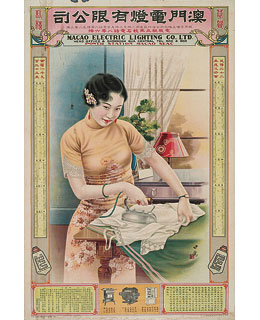
In China, it's no longer shocking to see sexy adverts peddling everything from perfume to hamburgers. Popular perception attributes this to the mass-marketing methods adopted during the past 30 years of economic liberalization, but in fact the transformation of the Chinese woman from coy maiden to poster girl has been a far longer process.
The first inklings of change date to the early part of the 20th century, when middle-class urban women — benefiting from increased educational opportunities and influenced by their Western counterparts — began cutting and perming their hair, refusing to bind their breasts and feet and wearing shorter, tighter dresses, often with revealing slits.
A new exhibit at Macau's Museum of Art explores this first wave of liberalization. "Modern Times: Chinese Women in Advertising" features more than 60 advertising posters that date from the 1910s to the 1940s. Most were printed from hand-painted Shanghainese originals, but a few also hail from Hong Kong and Macau, which by being foreign enclaves were also crucibles of change. A 1938 ad for W.D. & H.O. Wills Bristol & London cigarettes shows a statuesque woman stepping off an aircraft in a form-fitting blue cheongsam. In a poster for Indanthrene Cloth, two schoolgirls carry not only flowers but also a stack of books, as if to underscore the idea that the female of the era was no longer a simple domestic but also educated.
During the Cultural Revolution, most of these posters were destroyed as symbols of bourgeois society, but the precious few that survived have become pricey collectors' items and the source of cheap replicas now found in antique markets throughout Asia. Complete with creases and cracks, the works in "Modern Times" are the real thing.
The exhibit ends on Feb. 8, and at just 60 cents, the admission fee makes it one of the best bets in this casino town. For more information, go to www.artmuseum.gov.mo.